This article needs additional citations for verification .(February 2021) |

Captain Richard Avery Hornsby (died 1818) was an 18th-century British military figure, famous for successfully taking on a boat full of French pirates.
This article needs additional citations for verification .(February 2021) |

Captain Richard Avery Hornsby (died 1818) was an 18th-century British military figure, famous for successfully taking on a boat full of French pirates.
Hornsby lived on Vine Street in Sunderland, Tyne and Wear, at the time of the War of the Austrian Succession. He was set to take his brig, the Wrightson and Isabella, to The Hague. The ship was designed for a routine voyage, boasting only a crew of seven, with four small guns, two swivel cannons, and a few blunderbusses.
The Marquis of Brancas, with a crew of 75 French pirates, as well as ten guns, eight swivel cannons, and 300 small arms, spotted the Wrightson and Isabella off of the Dutch coast, and engaged the ship in combat on 13 June 1744. The two ships battled for an hour, including two failed attempts by the French to board the Isabella.
When a shot from the British side caused the Brancas to sheer off, Hornsby put the Union Jack back up and led his crew in giving the pirates three rousing cheers. The Brancas returned, however, with a volley of shots that wounded Hornsby in the temple. When the French ship once again drew alongside the British brig, the pirates on the Brancas refused their captain's demands to go aboard and face Hornsby. Admitting defeat, the French captain cut the lashings and started to sail away, only for his vessel to explode a few moments later. Of the 75 sailors on board, 36 were killed or wounded in battle, and all but three drowned upon its sinking.
At a ceremony held at Kensington Palace in September 1744, Hornsby was awarded a gold medal and a chain worth £100 by King George II for his bravery. Each of his men was given a bounty of £5, while the two boys in his crew were awarded 40 shillings each.
It was believed that Captain Hornsby was buried in St. Michael & All Angels Churchyard, Houghton-le-Spring, near Sunderland. However, a search of the burial registers by local historian Paul Lanagan revealed that the Richard Hornsby who was buried in the churchyard had died in 1818 at the age of 67, meaning that he would have been seven years old at the time of the pirate incident.
At least two British naval songs and ballads have been written about Hornsby, one titled "Brave Captain Hornsby," and the other titled "A New Song in Praise of Brave Captain Hornsby." [1]

Robert Maynard was a British lieutenant, and later captain, in the Royal Navy. Little is known about Maynard's early life, other than he was born in England in 1684 and then later joined the English Navy. He was made a lieutenant in January 1707, and by 1709 was the third lieutenant on HMS Bedford.

HMS Anson was a ship of the Royal Navy, launched at Plymouth on 4 September 1781. Originally a 64-gun third rate ship of the line, she fought at the Battle of the Saintes.

HMS Apollo, the fifth ship of the Royal Navy to be named for the Greek god Apollo, was a fifth-rate frigate of the Lively class, carrying 38 guns, launched in 1805 and broken up in 1856.
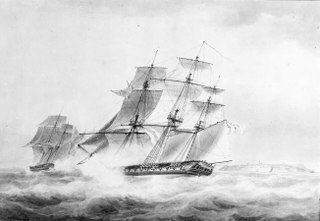
HMS Phoenix was a 36-gun Perseverance-class fifth-rate frigate of the Royal Navy. The shipbuilder George Parsons built her at Bursledon and launched her on 15 July 1783. She served in the French Revolutionary and Napoleonic Wars and was instrumental in the events leading up to the battle of Trafalgar. Phoenix was involved in several single-ship actions, the most notable occurring on 10 August 1805 when she captured the French frigate Didon, which was more heavily armed than her. She was wrecked, without loss of life, off Smyrna in 1816.

HMS Alceste was built at Rochefort in 1804 for the French Navy as Minerve, an Armide-class frigate. In the spring of 1806, prior to her capture, she engaged HMS Pallas, then under Lord Cochrane. During the duel she ran aground but Cochrane had to abort his attack when French reinforcements appeared.
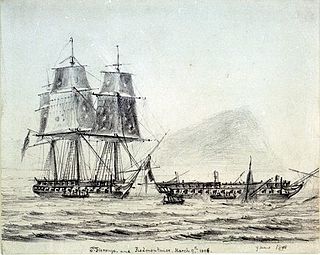
Minerve was a 40-gun frigate of the French Navy, lead ship of her class. She operated in the Mediterranean during the French Revolutionary Wars. Her crew scuttled her at Saint-Florent to avoid capture when the British invaded Corsica in 1794, but the British managed to raise her and recommissioned her in the Royal Navy as the 38-gun fifth rate HMS St Fiorenzo.

The Battle of Lake Pontchartrain was a single-ship action on September 10, 1779, part of the Anglo-Spanish War. It was fought between the British sloop-of-war HMS West Florida and the Continental Navy schooner USS Morris in the waters of Lake Pontchartrain, then in the British province of West Florida.

L'Espoir was a French brig-sloop that served for 9½ years in the French Navy before HMS Thalia captured her in September 1797. In her subsequent short career in British service as HMS Espoir she captured three prizes, with the capture in 1798 of the more heavily armed Genoese pirate Liguria earning her crew a clasp to the Naval General Service Medal. Espoir was laid up in 1799 and sold in 1804.

The Capture of the sloop William refers to a small single ship action fought between John "Calico Jack" Rackham and English privateer Jonathan Barnet. The battle was fought in the vicinity of Negril, Jamaica and ended with the capture of Rackham and his crew.
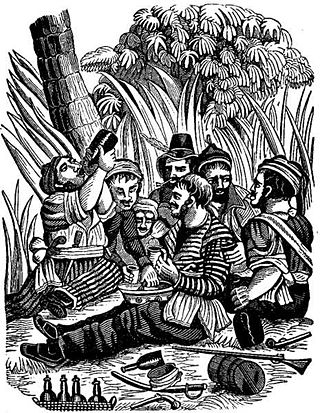
The Battle of Cape Lopez was fought in early 1722 during the Golden Age of Piracy. A Royal Navy man-of-war under Captain Chaloner Ogle defeated the pirate ship of Bartholomew Roberts off the coast of Gabon, West Africa.

The Battle of Tonkin River was a major naval battle fought in northern Vietnam between the pirates of Shap Ng-tsai and the British Royal Navy with aid from the Qing Chinese navy and the Tonkinese. The 1849 expedition led to the destruction of Shap Ng-tsai's fleet and the loss of over 2,000 men. The battle occurred over a three-day period at the mouth of the Tonkin River, near present-day Hai Phong.

The Battle of Fayal was a naval engagement between the United States and the United Kingdom fought in September 1814 during the War of 1812 in the Portuguese city of Horta, Faial, in the Azores. Three British warships and several boats filled with sailors and marines under assignment for the Louisiana Campaign attacked an American privateer in port. After repulsing two attacks from British troops and sailors, killing one of their commanders, the Americans won a tactical victory and scuttled their ship the following morning to prevent its capture.

HMS Peterel was a 16-gun Pylades-class ship-sloop of the Royal Navy. She was launched in 1794 and was in active service until 1811. Her most famous action was the capture of the French brig Ligurienne when shortly after Peterel captured two merchant ships and sent them off with prize crews, three French ships attacked her. She drove two on shore and captured the largest, the 14-gun Ligurienne. The Navy converted Peterel to a receiving ship at Plymouth in 1811 and sold her in 1827.

The West Indies Anti-Piracy Operations refer to the United States Navy presence in the Antilles, and surrounding waters, which fought against pirates. Between 1817 and 1825, the American West Indies Squadron constantly pursued pirates on sea and land, primarily around Cuba and Puerto Rico. After the capture of Roberto Cofresi in 1825, acts of piracy became rare, and the operation was considered a success, although limited occurrences went on until slightly after the start of the 20th century.
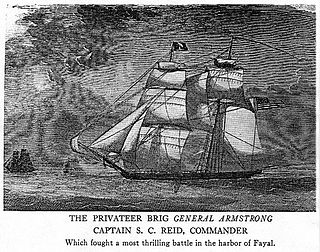
General Armstrong was an American brig built for privateering in the Atlantic Ocean theater of the War of 1812. She was named for Brigadier General John Armstrong, Sr., who fought in the American Revolutionary War.

The Battle off Mukah was a naval engagement fought in May 1862 between boats of the Sarawak and pirates. After the kidnapping of Sarawakian citizens some time before, two small gunboats encountered the pirates off Mukah on the northern coast of Borneo. In an unusual action, the Rajah Muda, Captain John Brooke, then the heir apparent to be White Rajah of Sarawak, led his force in the defeat of six pirate ships and the rescue of captured civilians.
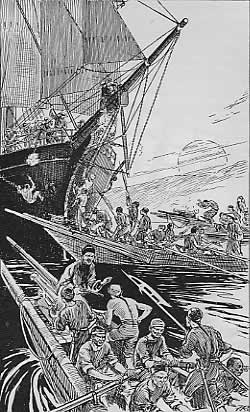
The North Star affair occurred in May 1861 when Chinese pirates attacked the British merchant ship North Star. Several men were killed in the incident, including a Royal Navy officer. The pirates escaped capture with 4,000 dollars' worth of gold.

HMS Cambrian was a Royal Navy 40-gun fifth-rate frigate. She was built and launched at Bursledon in 1797 and served in the English Channel, off North America, and in the Mediterranean. She was briefly flagship of both Admiral Mark Milbanke and Vice-Admiral Sir Andrew Mitchell during her career, and was present at the Battle of Navarino. Cambrian was wrecked off the coast of Grabusa in 1828.

The Dutch ship sloop Havik was launched in 1784 and served in the Batavian Navy. The British captured her in 1796 at the capitulation of Saldanha Bay. She then served briefly in the Royal Navy as HMS Havick before she was wrecked in late 1800.
HMS Briseis was a 10-gun Cherokee- class brig-sloop of the Royal Navy, launched in 1808 at Upnor, on the River Medway. She participated in one notable single ship action before she wrecked in 1816.